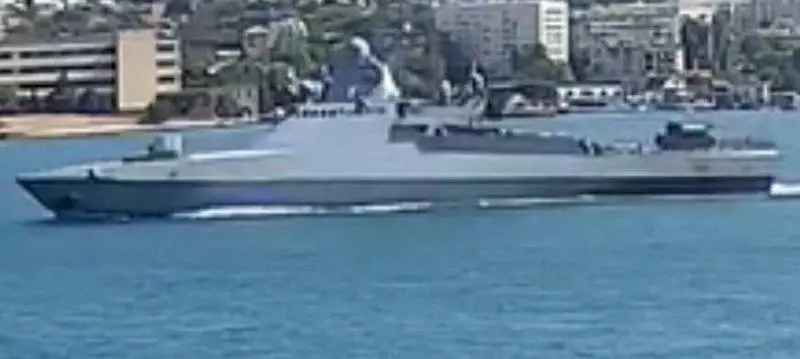Self-propelled anti-aircraft missile systems “Tor-M2KM air defense system” and “Pantsir” were urgently put on the ships of the Black Sea Fleet. Let’s figure out what that means.
Until recently, Russians did not take anti-ship cruise missiles seriously. For them, it was not a problem – Russians spot on the approach by radio emission, they shot traps, that is, chaff, and the rocket becomes disoriented. And the cost of traps is cheap. They are based on foil strips of different lengths, which are thrown into the air with the help of a pyrotechnic charge. The length of the strips for effective deception should be half the length of the radio wave on which the missile’s radar operates. Since it can be different, the strips in the trap also differ in length.
Silent anti-ship missiles
However, the new generation of anti-ship missiles works differently. They do not emit a radio signal since they use an inertial guidance system; that is, they navigate the terrain, estimating their position using gyroscopes and accelerometers and referring to the map stored in their memory. They can fly at a low altitude to remain unnoticed due to the curvature of the Earth, and on approach, they are aimed at the target by its thermal radiation. They can be confused by heat traps, but for this, one needs to have time to detect the missile.
For example, the Norwegian Naval Strike Missile (NSM), Russian Kh-35s and Onyxes use inertial guidance. Moreover, the Norwegian ones are made of composite materials that do not reflect at all and can manoeuvre on approaching the target.
The Russian Army managed to prepare for the fight against modern cruise missiles, but the Russian Navy, for some reason, did not. Probably, there just wasn’t enough time. But the Norwegians created NSM in 2007, 15 years ago. Well, maybe they didn’t allocate money. The result is the same: not ready.

Last month, a Ukrainian journalist spotted Project 22160 ship Vasily Bykov of the Russian Black Sea flotilla with a Tor air defense system on the landing helipad to protect against air attacks taken in the bay of Sevastopol.
By the end of the year, it seems the Russian Navy planned to equip the ships with marine versions of the Tor, 3K95 Kinzhal, as per TASS, but now there is no time to wait. Therefore, the land-based “Tors” and “Pantsirs” were fixed on the decks. Project 22160 ships Vasily Bykov, Dmitry Rogachev, Pavel Derzhavin and Sergey Kotov, are set to receive the naval Tor version. Pantsir-M is the naval version of Pantsir missile system
Currently, these ships are equipped with Igla-S and 9K333 Verba short-range complexes, making this type of ship defenseless against not just the modern anti-ship systems and aviation but even strike UAVs, for example, the Bayraktar TB2.
What are “Tor” and “Pantsir”
Despite similar tasks, these two systems have significant differences. The Pantsir has a maximum range of 20 kilometres, and the Tor has 16. The Pantsir has 12 missiles and a coaxial machine gun with a rate of fire of up to 5000 rounds per minute, and the Thor has 16 missiles. Are machine guns fired at cruise missiles? Yes, and how. Anti-missiles have a kill zone of a kilometre. If the distance is less, they will not have time to aim. And machine guns have practically no kill zone. But the Tor missiles are more powerful and give a larger area of destruction.
In addition, the Pantsir radar can detect objects with an effective scattering area of two square centimetres and the Tor – from five. The “Pantsir” also has an optical detection system.
Back in 2020, Pantsir was tested on ships against Kornet missiles. They are small and difficult to detect, but the system handled them perfectly.
The key point is that the fleet does not stop there and still receives ship modifications of the “Pantsir” and “Tor”. There is nothing more permanent than temporary.
Russian Ship air defense
Russian ship designers ignored or could not deploy effective air defense on new ships. The S-350E Vityaz 50R6 medium-range surface-to-air, which was renamed from Poliment-Redut to Resurs, is the most modern air defense system of the Russian Navy. Steregushchiy-class corvette, Gremyashchiy-class corvette, Project 20386 corvette, and Admiral Gorshkov-class frigate are equipped with the system. This system received three types of missiles common with the S-350 Vityaz ground-based air defense system. Two known missiles are the 9M96E guided missile and the 9M100 guided missile. 9M100 can be quad packed in the naval version Resurs and has an effective range of 10–15 km (6.2–9.3 mi). 9M96E missile has a range of 40 km, and 9M96E2 has a range of about 120 km.
Soon after the sinking of Moskva, the entire naval group in the Black Sea was provided with cover with echeloned air defense in the form of the S-300F and Osa-MA air defense systems.
